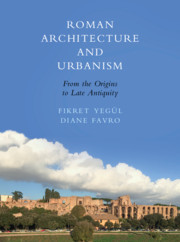Book contents
- Roman Architecture and Urbanism
- Roman Architecture and Urbanism
- Copyright page
- Contents
- Preface and Acknowledgments
- Maps
- Introduction
- 1 Urban Design and Architecture in Rome and Italy during the Republic and the Early Empire
- 2 Temple Architecture of Republican Rome and Italy
- 3 Technology of Building
- 4 Julio-Claudian Architecture in Rome
- 5 Residential Architecture
- 6 Imperial Architecture in Rome from the Flavians through the Antonines
- 7 Architecture and Planning in Italy and the Western Provinces
- 8 Architecture and Planning in North Africa
- 9 Greece under Roman Rule
- 10 Architecture and Planning in Asia Minor
- 11 The Roman Near East
- 12 The Late Empire in Rome and the Provinces
- General Bibliography
- Glossary
- Index
- Plate Section (PDF Only)
- References
11 - The Roman Near East
Published online by Cambridge University Press: 21 August 2019
- Roman Architecture and Urbanism
- Roman Architecture and Urbanism
- Copyright page
- Contents
- Preface and Acknowledgments
- Maps
- Introduction
- 1 Urban Design and Architecture in Rome and Italy during the Republic and the Early Empire
- 2 Temple Architecture of Republican Rome and Italy
- 3 Technology of Building
- 4 Julio-Claudian Architecture in Rome
- 5 Residential Architecture
- 6 Imperial Architecture in Rome from the Flavians through the Antonines
- 7 Architecture and Planning in Italy and the Western Provinces
- 8 Architecture and Planning in North Africa
- 9 Greece under Roman Rule
- 10 Architecture and Planning in Asia Minor
- 11 The Roman Near East
- 12 The Late Empire in Rome and the Provinces
- General Bibliography
- Glossary
- Index
- Plate Section (PDF Only)
- References
Summary
When a traveler from Italy, after two weeks of perilous sea travel, set foot on one of the renowned ancient ports of Syria, it was not only the thousand miles or more of open seas that separated him from home but also a cultural divide evident in the diverse faces, languages, and customs. Indeed, many of these busy ports, from Laodicea to Caesarea, rooted in their Phoenician or Greek past, were only moderately familiar sea gates opening to the increasing unfamiliarity of the interior – a world populated by Semitic and Arab communities stretching over the vast, stony steppes of Syria, Jordan, and Arabia, across the great rivers of Euphrates and Tigris to the venerable civilizations of Mesopotamia and Persia deep into the edges of the desert. Beyond that, the great and legendary land routes to India, China and southeast Asia beckoned the fearless traders. This was a world of great diversity in some ways similar to, but in others significantly different from, Asia Minor where the coastal regions had been populated by Greek colonies from the first millennium onward and consequently established a culture and language that was predominantly and genuinely Hellenic. Even inland Anatolia, with its native populations, such as the Phrygians, Lydians, and Carians, had been substantially Hellenized and more importantly urbanized by the time of the Roman dominion of the land. This world all changed east of the Cilician Gates. There is much truth in the colorful (and now simplistic sounding) characterization by J. B. Ward-Perkins that once we turn to eastern Mediterranean and the lands beyond, the duet represented elsewhere by the Greek and Roman traditions “becomes … a chorus of mixed voices,” although, as we have tried to underline earlier, there were a few important voices other than Greek and Roman even in Italy and the Western provinces (Ward-Perkins 1982, 307).
- Type
- Chapter
- Information
- Roman Architecture and UrbanismFrom the Origins to Late Antiquity, pp. 707 - 799Publisher: Cambridge University PressPrint publication year: 2019



